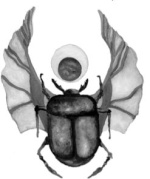Similar topics
"Pop and Circumstance" -
Page 1 of 1
 "Pop and Circumstance" -
"Pop and Circumstance" -
See Gnosis Magazine for the complete article:


Pop and Circumstance:
by Jay Kinney
For us Americans, popular culture is the sea in which we swim. In ever accelerating fashion, the old distinctions between so-called high culture (opera, classical music, fine art, theatre, and "serious" literature) and popular culture (movies, TV, pop music, "trash" fiction, and everything from monster truck races to folk art) have evaporated. What is left is simply pop culture: the spectacular onslaught of rock operas, CD-ROM porn, NEA-funded performance art in nightclubs, infotainment, 900 numbers, celebrity journalism, Tina Brown's New Yorker, John Wayne Bobbitt's penis, Nancy Kerrigan's knee, Allen Ginsberg in Gap ads, Shirley MacLaine as spiritual adviser, Rush Limbaugh as political oracle, and on and on.
Like most contemporary Americans, I was raised on a steady diet of popular culture. When I was young, I prized my stacks of comics and Mad magazines, went to sleep at night with my earplug crystal radio tuned to the local Top 40 station, and parroted lines from TV commercials in unison with my grade-school classmates. The Beatles and the rest of the British Invasion arrived in full force when I was thirteen, the perfect age to experience Beatlemania firsthand.
In high school I joined the ranks of science fiction fandom, found profundities in Robert Heinlein's Stranger in a Strange Land, and orated on the metaphysics of Jimi Hendrix's first album for senior honors English class. The story is much the same for my college and art school years: I quickly became a published underground cartoonist and began producing pop artifacts as well as consuming them.
Of course I was operating with the comforting assumption that the pop artifacts that I was producing were part of a countercultural project doing battle with the insidious brain-numbing pop artifacts of mainstream culture. However, it only took the passage of twenty years and a few trips to other parts of the globe to realize that these distinctions were lost on most non-Americans. From their point of view, this was all American stuff, exuding that American naivete and vitality which the rest of the world finds so amusing. Pop was pop, and parts is parts, as the commercial goes.
Fast forward to 1994 and the GNOSIS office. Here we sit contemplating the hazardous interaction of popular culture and the esoteric. Does popularization cheapen that which it spreads? Can the subtleties of the ineffable survive the gauntlet of the assembly line and market place? When did the commercialization of the New Age reach the point of no return? Is this very magazine an example of that which it decries? Good questions all, and here we sit contemplating them in our navel-gazing way when The PoMo Tarot arrives.
In case you haven't seen this newly published Tarot deck by Brain Williams (HarperSanFrancisco, 1994; $30) let me describe it briefly. Better still, let me quote from its accompanying press release. "In The PoMo Tarot, Williams satirically co-ops [sic] pop icons, modern art, and the tarot and recasts them as immediately recognizable -- yet completely new -- images that transcend both art and the tarot. . . . Williams replaces the traditional suits of the Minor Arcana (staves, cups, coins, and swords) with TV's, bottles, money, and guns -- bringing a fresh relevance to this ancient divination tool."
Now there are two ways of looking at this item. The first is to embrace a certain playful spirit and chuckle knowingly: "Ah, now here's a Tarot for the '90s! It sums up the urban angst with an ironic cuteness that will be right at home for doing a spread over a couple of cappuccinos down at the neo-boho coffeehouse!" The second is to throw up one's hands in disgust and mutter expletives. "This @*#%$ deck is the ultimate in cynicism and triviality! It perfectly illustrates the fate of the esoteric in pop culture! Where's my Uzi?"
In either case, The PoMo Tarot highlights the tension between tradition and innovation, and between form and content -- two sets of polarities between which popular culture is continually caught. With the Tarot, you have a tradition that has grown by accretion, with later designers and thinkers building upon and superseding earlier renderings. In this respect the Tarot has been remarkably open to innovation. Yet the theory persists that the Tarot's original intention was as a set of didactic emblems that encoded an esoteric teaching. If this is true -- and some of the best commentators upon the Tarot, such as Paul Foster Case and Valentin Tomberg, have operated from the assumption that it is -- then to deviate too much from the traditional Arcana is to betray its purpose.
Then again, it can be argued that the typical Tarot buyer is not looking for encoded Hermetica at all. She (or he) is looking for a tool of divination akin to the I Ching that can encapsulate the present and point to the future. For this purpose, the cards themselves are secondary to the patterns of randomness that they portray when shuffled and dealt. Just as a "valid" I Ching reading can be thrown with three pennies from your change purse, so one could presumably derive a meaningful Tarot spread from a deck featuring Bugs Bunny and Elmer Fudd: what's on the cards is largely irrelevant.

Khephra- Age : 59
Number of posts : 897
Registration date : 2008-08-10
 Similar topics
Similar topics» "Torah" & "Nomos"
» "Review: 'Frances Yates and the Hermetic Tradition', by Marjorie G Jones" -
» "Dr. Steven Greer presents 'Contact & Disclosure: The Final Sequence'" -
» "Review: 'Frances Yates and the Hermetic Tradition', by Marjorie G Jones" -
» "Dr. Steven Greer presents 'Contact & Disclosure: The Final Sequence'" -
Page 1 of 1
Permissions in this forum:
You cannot reply to topics in this forum
